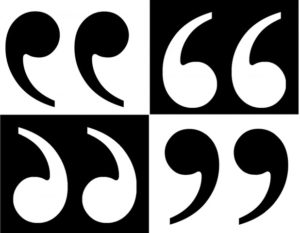Bits and Pieces
Thoughts on Re-reading Ready, Fire, Aim:
The Inevitable Bloating of Corporate Payroll

If your business grows long or large enough, you are going to encounter payroll bloat – some number of employees at all levels of the biz that contribute little or nothing to the bottom line.
During the early stages of your company’s growth, you won’t have any trouble noticing this corporate rot and getting rid of it. That’s because (1) as the initial CEO of a relatively small company you will be close enough to see it. And (2) as the founder and principal shareholder, you will not tolerate waste.
But when the business gets larger – with tens of millions of dollars in revenues and several hundred employees – you will be far removed from the front lines. And those well-paid, low-to-no-contribution workers will start to disappear from your sight. You won’t notice them physically, because they’ll be floors or buildings or even cities away. And you won’t notice them on the P&Ls, because their costs will be several levels subordinated to the lines you are looking at.
I’ve seen this happen more than once. Because my interest in business is growth, when revenues and profits are rising, I’m not looking for leaks. But whenever I have looked, there’s always been some level of payroll waste.
I’m talking about redundant jobs. Full-time employees being paid to do part-time work. Highly paid execs doing little more than intermediating information.
What was scary about many of these investigations was that nobody was saying a damn thing about them. Not the department heads or management teams. Not the accounting department. And, of course, not a word from the employees that were underchallenged.
I don’t think these people were “covering up.” I think they simply weren’t aware of what had happened. The erosion of personnel productivity took place over years, little by little. Big-business regulations kicked in at a certain level, requiring the firing of red-tape processers. And certain functions, once necessary, became vestigial.
Carl Icahn, one of Wall Street’s most successful investors, ran into that problem several times in his career of building several huge businesses. I remember reading in one of his books or perhaps a magazine article that he made it a practice to fire 10% of his employees each year.
That could be apocryphal. I hope it isn’t, because I always thought it highlighted this problem – that with every additional layer of growth there will likely be an extra layer of low-output employees that must be repurposed or dismissed.
Click here to listen to Icahn tell a funny story about one of the times that he dealt with this problem.
News & Views: Law & Disorder Update

In my effort to keep you abreast of the rise in violent crime in America’s largest cities, here are three quick updates:
* Car thefts rampant in Portland. Click here.
* Chicago 2021: highest number of homicides in 25 years. Click here.
* Rookie cop gets shot on way to work in New York. Click here.
Interesting: About US Military History
How Many Times Has the US Declared War?

The United States has officially declared war 11 times during five separate military conflicts. The last time was during World War II.
The Korean War, the War in Vietnam, and the extended campaigns in Afghanistan and Iraq were not officially “wars.” They were military “actions” or “conflicts.”
The difference matters. According to the Constitution, our presidents are not authorized to declare war. Only Congress is. The founding fathers wisely wanted to make it difficult for us to get into expensive and deadly military engagements. It was almost as if they anticipated President Eisenhower’s 1961 warning about the “military-industrial complex”:
“In the councils of government, we must guard against the acquisition of unwarranted influence, whether sought or unsought, by the military-industrial complex. The potential for the disastrous rise of misplaced power exists and will persist.” – Dwight D. Eisenhower
From Letters of Note: John Steinbeck to His Lovesick Son, Nov. 10, 1958
“Thom,
“There are several kinds of love. One is a selfish, mean, grasping, egotistical thing which uses love for self-importance. This is the ugly and crippling kind. The other is an outpouring of everything good in you – of kindness and consideration and respect – not only the social respect of manners but the greater respect which is recognition of another person as unique and valuable. The first kind can make you sick and small and weak but the second can release in you strength and courage and goodness and even wisdom you didn’t know you had….
“And don’t worry about losing. If it is right, it happens. The main thing is not to hurry. Nothing good gets away.”
Great Places to Visit When You’re in LA:
The Getty Villa Museum

You’ve heard of The Getty Center in LA. By any standard, the museum and gardens are a must-see. Less known, but well worth a sunny morning, is the Getty Villa Museum in Malibu.
Another legacy project of J. Paul Getty, it is dedicated to the study of Greek and Roman art and culture. The collection is huge, with more than 44,000 antiquities from 6,500 BC to 400 AD.
Worth Quoting

* “Success has always been easy to measure. It is the distance between one’s origins and one’s final achievement that matters.” – Michael Korda
* “To leave the world richer – that is the ultimate success.” – Eleanor Roosevelt
* “There is only one success… to be able to spend your own life in your own way,
and not to give others absurd maddening claims upon it.” – Christopher Morley
Readers Write…
Re the Feb. 3 issue:
CF on “The Digital Dollar” – “I thought your prediction was crazy when you made it. Now, I’m starting to believe!”
PJC on “The Problem With Managers Managing Up” – “Thank you for that piece on managers that ‘manage up.’ It came at just the right time. I’ve been puzzling about a profit center of our biz that has been falling off of late. I think you nailed it.”
AS on Buster Keaton vs. Charlie Chaplin – “I am still amazed at [Keaton’s] tenacity and creativity in a time well before special effects. How he didn’t break every bone in his body is a mystery.”
 MarkFord
MarkFord